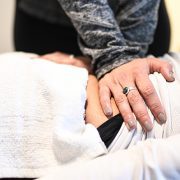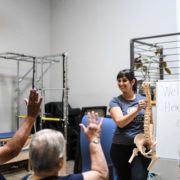5 Tips for Staying Active and Mobile as you Age
Most of our clients are in their 50’s, 60’s and 70’s, and they want to stay as active as possible as they age. However, as we get older, our bodies do need more care and maintenance to age well and avoid injury. Here are some tips we like to give our clients to help them stay active and mobile, prevent injuries, and continue doing everything they love!
1. Keep Moving
I always tell my clients: “You don’t get stiff because you get old, you get old because you get stiff.”
If you want to stay healthy and mobile, you need to keep moving. One of the biggest questions I hear from folks aged 50+ is what to keep doing or stop doing because of arthritis. Remember, arthritis is normal as you age and it’s rarely a reason to stop doing certain exercises. Research has shown that activities like running, when done consistently and with proper form, can actually prevent knee arthritis! A similar and equally effective exercise is walking. Consistent walks will build up your strength and endurance, something that declines as you age, and it helps your balance and coordination. If you walk outside, you can get some fresh air and Vitamin D, which is highly beneficial for a strong immune system – something we all need right now.
2. Maintain a Healthy Diet
What you eat directly affects your ability to keep moving. If you’re not keeping your bones and heart healthy, you’re not going to be able to exercise! Greens like kale, spinach, and arugula are awesome for your bones. Along with citrus fruits, fish, and nuts, these foods help your bones stay strong and durable, which is a big concern for our clients with osteoporosis.
When it comes to taking care of your heart, your diet can have a huge impact. According to Health magazine, “The risk of a heart attack climbs for men after age 45 and for women after age 55.” So as you enter middle-age, be sure to increase the presence of foods in your diet like unsalted nuts, unprocessed oatmeal, raisins, blueberries, and even dark chocolate (over 70% cacao) to help keep your heart healthy! If you have any comorbidities such as diabetes or kidney problems, be sure to check with your doctor or dietician before making any drastic changes to your diet.
3. Work on your Balance
Balance is one of the first things to go as a person gets older, and it’s one of the most crucial factors in helping you prevent falls and avoid injury. Slips and falls due to poor balance can lead to broken bones and fractures, which can be harder to recover from as you age. But if you’re diligent about exercising with the intention of improving your balance, you can maintain (and even improve) it far into your later years. As already mentioned, activities like walking regularly can help, along with activities such as Tai Chi and Yoga. And now, with everything so accessible via Zoom, you can take advantage of these types of activities right from your living room!
4. Strengthen your core
Having a strong core is beneficial at any age, but especially as you get older. Strong abs, hips and buttocks (all part of your core) help you to sit and stand more upright, prevent back and neck pain, and will help you feel stronger and more confident in just about everything that you do. In our office, our favorite core-strengthening activity is Pilates. We especially love it for folks aged 50+ because it’s easy on your joints and it helps to promote flexibility at the same time. We use specialized machines that are beneficial for folks recovering from an injury, and we’ve got Zoom classes requiring no equipment at all that people can do from home. Yet another reason to love Pilates is that it doesn’t just work your core, but your entire body. You can even do portions of Pilates in standing, which helps your balance and coordination! If you’ve never tried Pilates before, we’d love to help you get started.
5. Educate Yourself
Knowledge is power, and a lack of knowledge is one of the biggest reasons I see people decreasing their activity levels unnecessarily. People think that issues like arthritis, bulging discs, or a torn meniscus are reasons to decrease or cease certain activities altogether. But that’s not necessarily true! Most of the things I just mentioned are normal occurrences as we age, and having them show up on an x-ray or MRI is not a reason to change an activity you’ve been doing successfully for years. Plus, regular movement and exercise actually helps these problems.
If you have pain, that’s a different story. Talk to an expert who can help you figure out what’s going on so that you can quickly get back to your activities and not make your pain any worse. Whatever you do, try to avoid Dr. Google. It can send you down a rabbit hole and not all the advice you read will apply directly to you. If you’re dealing with pain that is keeping you from your favorite activities, reach out to experts like us. We offer a FREE 30 minute Discovery Session just so you can ask questions, get honest answers, and figure out if we’re the right fit for your lifestyle.





